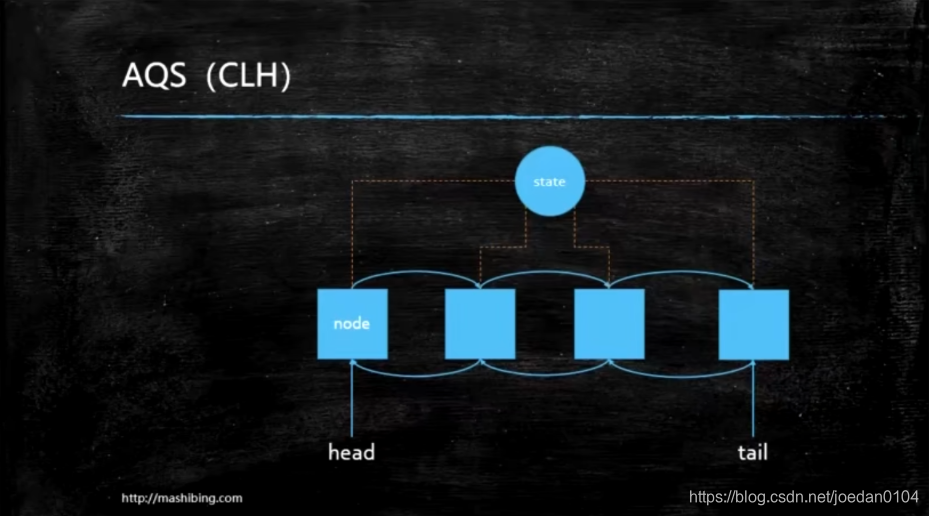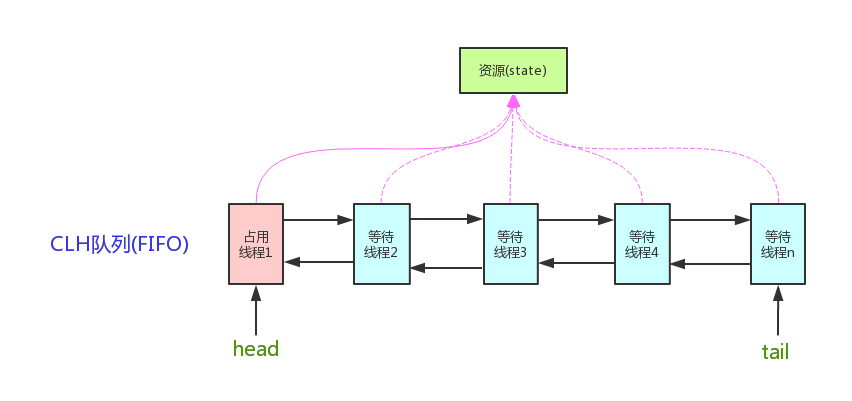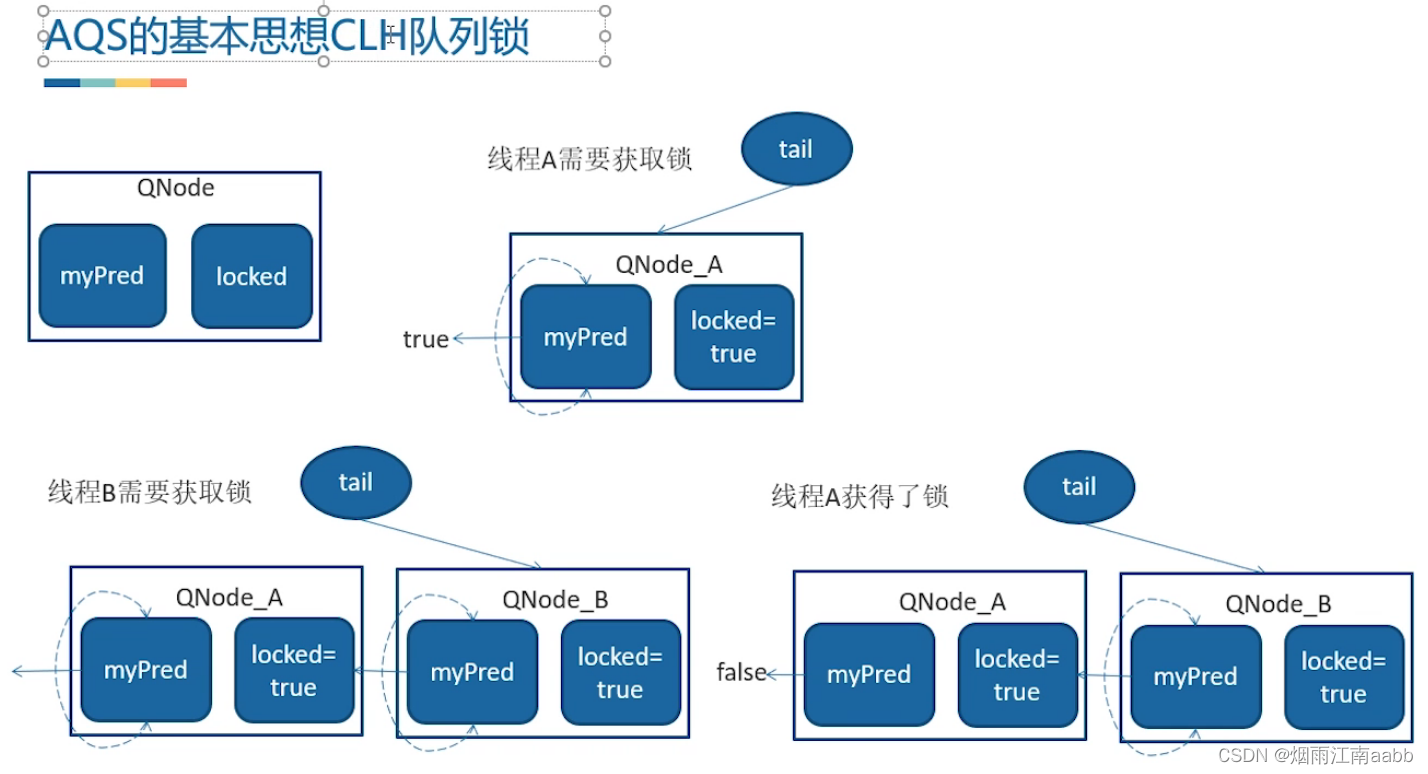1.什么是AQS
AQS是AbstractQueuedSynchronizer,抽象队列同步器,AQS定义了一套多线程访问共享资源的同步器框架。
AQS是一个通过内置的FIFO双向队列来完成线程的排队工作(内部通过结点head和tail记录队首和队尾元素,元素的结点类型为Node类型,后面我们会看到Node的具体构造)。
AQS定义两种资源共享方式:Exclusive(独占,只有一个线程能执行,如ReentrantLock)和Share(共享,多个线程可同时执行,如Semaphore/CountDownLatch)。
模板方法的设计模式。
2.AQS节点结构
static final class Node {
/**
* 当前线程的等待状态, taking on only the values:
* SIGNAL: The successor of this node is (or will soon be)
* blocked (via park), so the current node must
* unpark its successor when it releases or
* cancels. To avoid races, acquire methods must
* first indicate they need a signal,
* then retry the atomic acquire, and then,
* on failure, block.
* CANCELLED: This node is cancelled due to timeout or interrupt.
* Nodes never leave this state. In particular,
* a thread with cancelled node never again blocks.
* CONDITION: This node is currently on a condition queue.
* It will not be used as a sync queue node
* until transferred, at which time the status
* will be set to 0. (Use of this value here has
* nothing to do with the other uses of the
* field, but simplifies mechanics.)
* PROPAGATE: A releaseShared should be propagated to other
* nodes. This is set (for head node only) in
* doReleaseShared to ensure propagation
* continues, even if other operations have
* since intervened.
* 0: None of the above
*
* The values are arranged numerically to simplify use.
* Non-negative values mean that a node doesn't need to
* signal. So, most code doesn't need to check for particular
* values, just for sign.
*
* The field is initialized to 0 for normal sync nodes, and
* CONDITION for condition nodes. It is modified using CAS
* (or when possible, unconditional volatile writes).
*/
volatile int waitStatus;
/**
* 当前节点的前一个节点
*/
volatile Node prev;
/**
* 当前节点的下一个节点
*/
volatile Node next;
/**
* 当前节点对应的排队线程.
*/
volatile Thread thread;
/**
* 同步状态
*/
private volatile int state;2.1 结点状态waitStatus
这里我们说下Node。Node结点是对每一个等待获取资源的线程的封装,其包含了需要同步的线程本身及其等待状态,如是否被阻塞、是否等待唤醒、是否已经被取消等。变量waitStatus则表示当前Node结点的等待状态,共有5种取值CANCELLED、SIGNAL、CONDITION、PROPAGATE、0。
-
CANCELLED(1):表示当前结点已取消调度。当timeout或被中断(响应中断的情况下),会触发变更为此状态,进入该状态后的结点将不会再变化。
-
SIGNAL(-1):表示后继结点在等待当前结点唤醒。后继结点入队时,会将前继结点的状态更新为SIGNAL。
-
CONDITION(-2):表示结点等待在Condition上,当其他线程调用了Condition的signal()方法后,CONDITION状态的结点将从等待队列转移到同步队列中,等待获取同步锁。
-
PROPAGATE(-3):共享模式下,前继结点不仅会唤醒其后继结点,同时也可能会唤醒后继的后继结点。
-
0:新结点入队时的默认状态。
注意,负值表示结点处于有效等待状态,而正值表示结点已被取消。所以源码中很多地方用>0、<0来判断结点的状态是否正常。
3. AQS关键操作
3.1 AQS入列(addWaiter)
| 操作 | 方法 | 备注 |
| 入列 | addWaiter | 队尾插入节点 |
| 加锁(获取独占资源) | acquire | 此方法是独占模式下线程获取共享资源的顶层入口。如果获取到资源,线程直接返回,否则进入等待队列,直到获取到资源为止,且整个过程忽略中断的影响。这也正是lock()的语义, |
| 尝试加锁 | tryAcquire | 尝试去获取独占资源。如果获取成功,则直接返回true,否则直接返回false。这也正是tryLock()的语义 |
| 加锁和入列 | acquireQueued | 当前节点尝试加锁,加锁成功,则当前节点作为等待队列head;如果加锁失败,进入等待状态休息,直到其他线程彻底释放资源后唤醒自己,自己再拿到资源,然后就可以去干自己想干的事了。 |
参考文献:
1.马士兵2021年最新Java多线程高并发编程详细讲解


